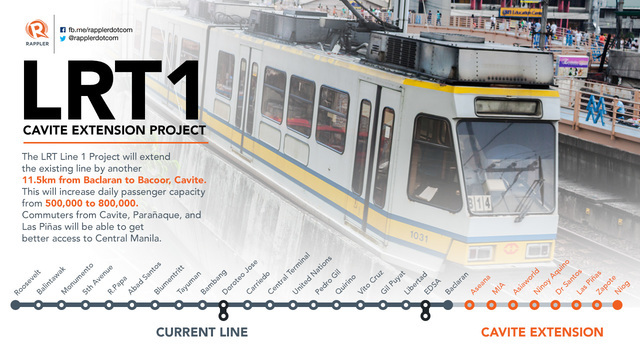The Manuel Pangilinan-led Light Rail Manila Corp. (LRMC), the operator of LRT Line 1, hopes to secure government approval of the proposed takeover of the Metro Rail Transit Line 3 (MRT-3) starting early next year.
"We hope sometime next year we can assume close loop ... Edsa, dulo-dulo, Roosevelt, then ikot all the way to Cavite," LRMC president and CEO Rogelio Singson said during a press conference in Pasay City on Thursday.
"It could be as soon as four to six months na iba na 'yung operator ng MRT-3," Singson said.
On July 14, Metro Pacific Investments Corp. and the other stakeholders of the LRMC—Ayala Corp.'s AC Infrastructure Holdings Corp. and Macquarie Infrastructure Holdings (Philippines) Pte. Ltd.— submitted an unsolicited proposal to the government on taking over MRT-3.
"The unsolicited proposal is a total complete package with contract provisions, because we are just lifting the same provisions of the concession agreement on the LRT-1," Singson said.
"In other words, imbis na iba 'yung operator at iba 'yung maintenance provider, our offer is we'll take over, just like the Line 1," he added.
Part of the MRT-3 takeover proposal is replacing the rail tracks and upgrading the power supply and the train stations, and improving the reliability of trains.
"Exactly what was done in Line 1," Singson said.
LRMC hopes the government will grant the company an original proponent status (OPS) for the planned takeover.
"Once you're given an OPS, the government can go through Swiss challenge to whoever wants to offer a similar proposal so there's a period of 90 days or 120 days that they have to go through a challenge," he said.
"Hopefully, the best proposal comes out by the first quarter of next year," he added. — VDS/KVD, GMA Mews
http://www.gmanetwork.com/news/money/companies/623997/pangilinan-led-lrmc-eyes-taking-over-mrt-3-early-next-year/story/
"We hope sometime next year we can assume close loop ... Edsa, dulo-dulo, Roosevelt, then ikot all the way to Cavite," LRMC president and CEO Rogelio Singson said during a press conference in Pasay City on Thursday.
"It could be as soon as four to six months na iba na 'yung operator ng MRT-3," Singson said.
On July 14, Metro Pacific Investments Corp. and the other stakeholders of the LRMC—Ayala Corp.'s AC Infrastructure Holdings Corp. and Macquarie Infrastructure Holdings (Philippines) Pte. Ltd.— submitted an unsolicited proposal to the government on taking over MRT-3.
"The unsolicited proposal is a total complete package with contract provisions, because we are just lifting the same provisions of the concession agreement on the LRT-1," Singson said.
"In other words, imbis na iba 'yung operator at iba 'yung maintenance provider, our offer is we'll take over, just like the Line 1," he added.
Part of the MRT-3 takeover proposal is replacing the rail tracks and upgrading the power supply and the train stations, and improving the reliability of trains.
"Exactly what was done in Line 1," Singson said.
LRMC hopes the government will grant the company an original proponent status (OPS) for the planned takeover.
"Once you're given an OPS, the government can go through Swiss challenge to whoever wants to offer a similar proposal so there's a period of 90 days or 120 days that they have to go through a challenge," he said.
"Hopefully, the best proposal comes out by the first quarter of next year," he added. — VDS/KVD, GMA Mews
http://www.gmanetwork.com/news/money/companies/623997/pangilinan-led-lrmc-eyes-taking-over-mrt-3-early-next-year/story/
